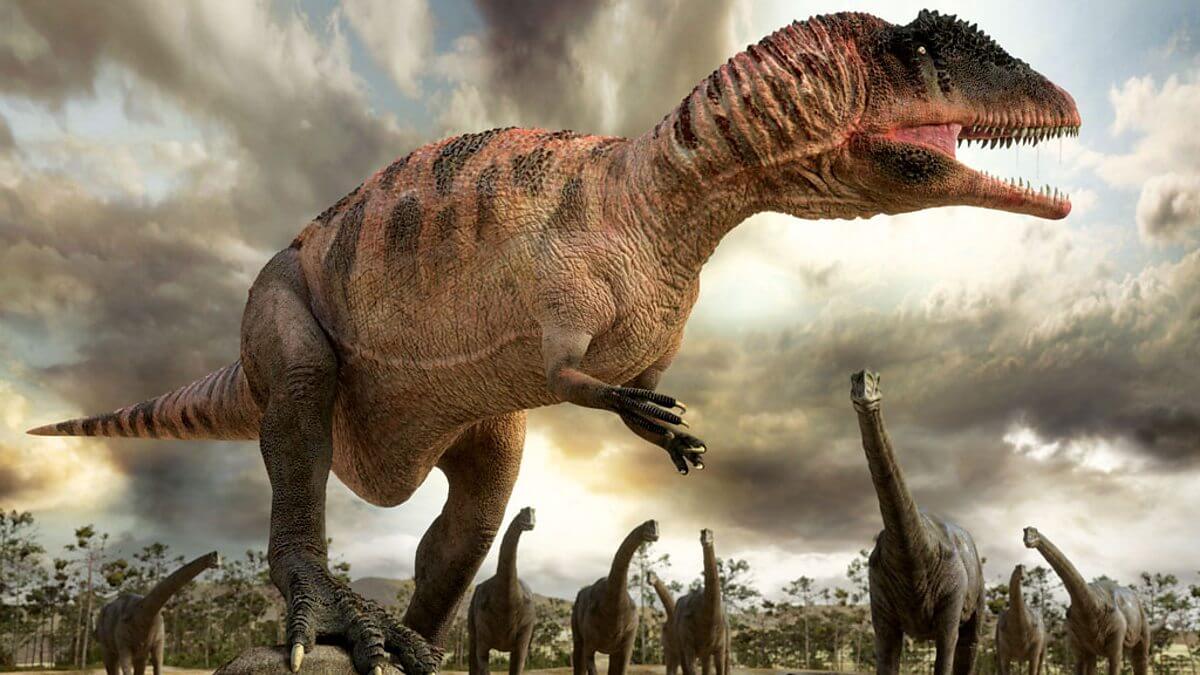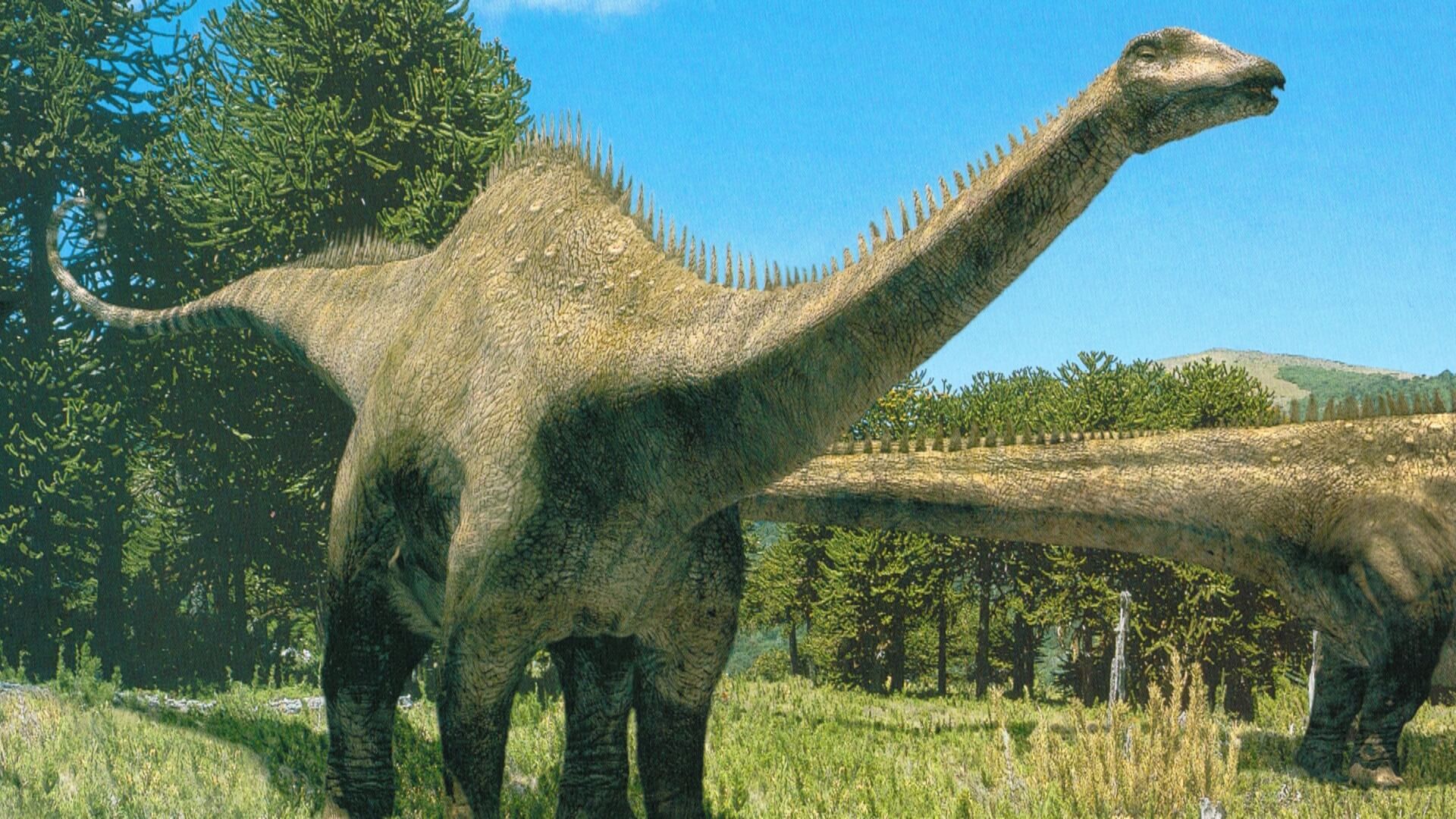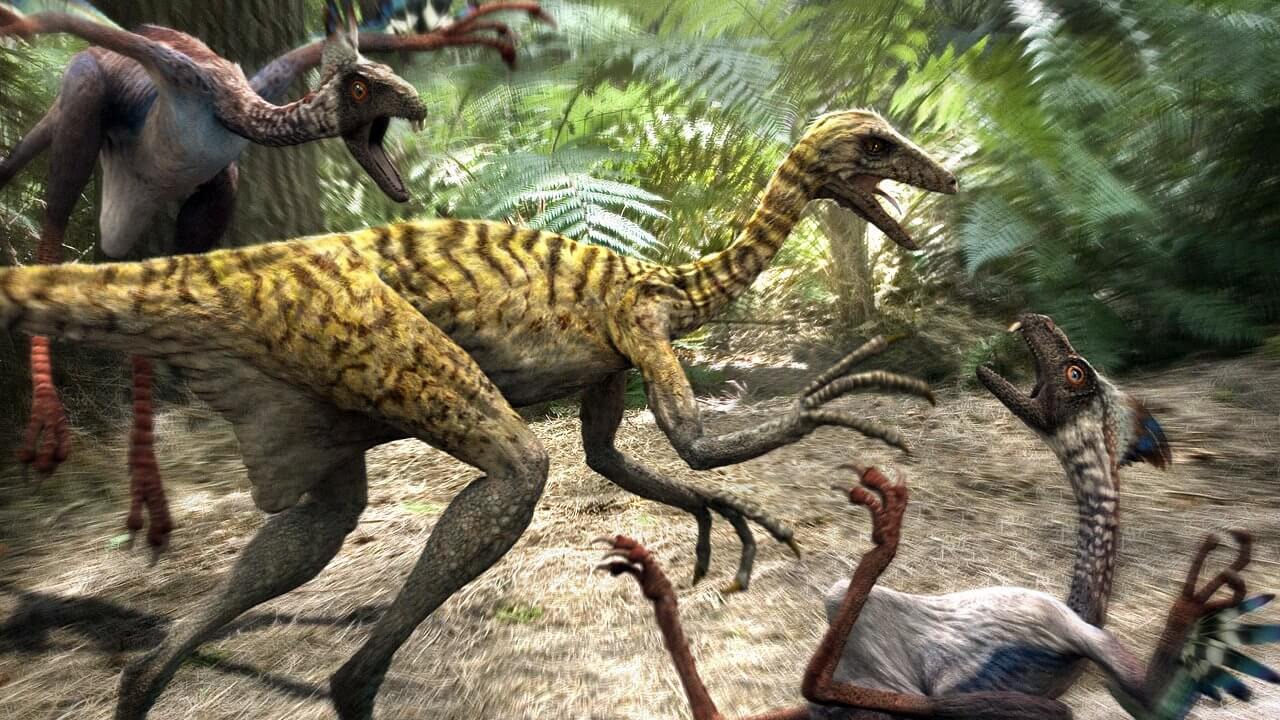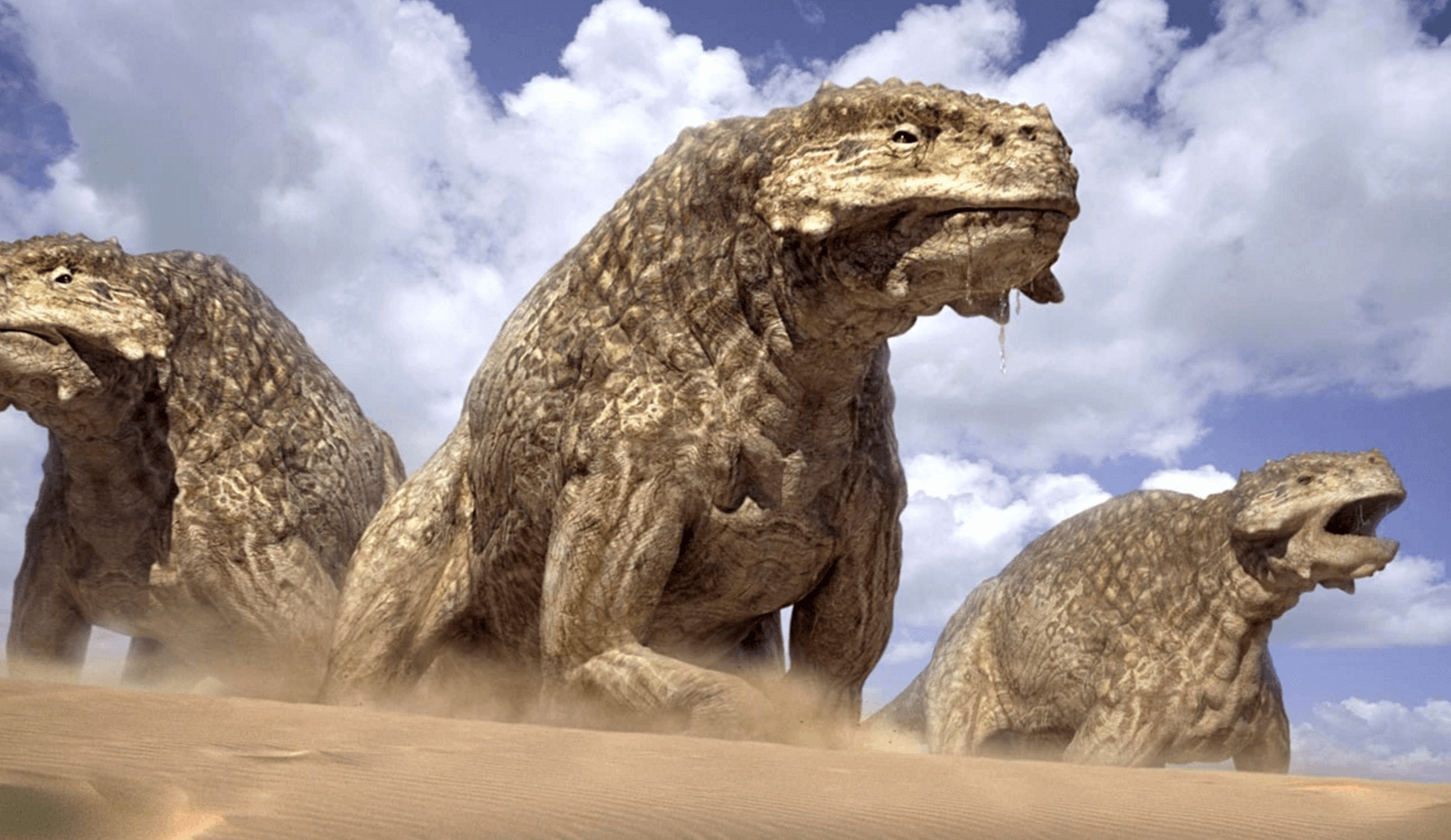description:
Planet Dinosaur is a six-part documentary television series produced by the BBC, narrated by John Hurt, first aired in the United Kingdom in 2011, produced by VFX studio Jellyfish Pictures. It is the first major dinosaur-related series for BBC One since Walking with Dinosaurs. There are more than 50 different prehistoric species featured, and they and their environments were created entirely as computer-generated images, for around a third of the production cost that was needed a decade earlier for Walking with Dinosaurs.
episodes:
01. Lost World
In a swamp in North Africa a herd of Ouranosaurus are spooked by a Spinosaurus, which ignores them. Instead, it hunts Onchopristis (a giant sawfish), which are migrating into freshwater rivers to breed. A Rugops feeds off its leftovers. The episode cuts to a pair of Carcharodontosaurus, which are fighting to gain hunting rights to a herd of Ouranosaurus. The victor then hunts and kills one of the herbivores. The episode then cuts to the Spinosaurus habitat, where a drought is taking place and the Spinosaurus, scared away from the remaining water by a Sarcosuchus (which unlike the dinosaur can hibernate during droughts), is forced to hunt on land. After killing and eating a pterosaur, it comes across a group ofOuranosaurus. Catching the scent of a kill, it discovers a Carcharodontosaurus, which has brought down one of the iguanodonts. After a fight over the carcass, the Spinosaurus drives off the other theropod, although its sail is seriously injured. The narrator explains that a million years later, rising sea levels destroyed the Spinosaurus habitat, causing the species to go extinct.
02. Feathered Dragons
In a late Jurassic forest in what is now China, an Epidexipteryx escapes from a juvenile Sinraptor by climbing a tree. It finds a beetle grub in the tree bark, being shown to use its elongated fingers in a similar way to a modern day aye-aye. However, its prey is stolen by another, largerEpidexipteryx, and after a brief bout of posturing, the smaller individual goes to find more food. It drops a second grub to the forest floor, where the other Epidexipteryx retrieves it, only to be killed by the juvenile Sinraptor. The episode then cuts to a desert in late Cretaceous Mongolia, where aSaurornithoides is shown brooding a nest of eggs. When it leaves the nest, an Oviraptor raids it, fleeing when the troodontid returns. TheSaurornithoides is suddenly attacked and eaten by a Gigantoraptor, which then heads to compete in a breeding ritual for mates. The males use their feathers for display, a brief fight between two erupting at one point, allowing the females to choose the best suitor. The episode finally cuts to an early Cretaceous forest in China, where a Xianglong is being hunted by a Microraptor, which uses its feathers to pursue the gliding lizard in the air. A Sinornithosaurus attacks it, and after a brief chase the Microraptor manages a lucky escape. The Sinornithosaurus is then shown hunting aJeholosaurus and its three young, along with two other members of its species. The group brings down the parent, the narrator explaining that their possibly venomous bite allowed them to tackle animals much larger than themselves. A montage is then shown of the feathered dinosaurs featured in the programme, with the narrator saying that Microraptor not only hints at how flight might have developed, but also that dinosaurs still live amongst us today, as birds.
03. Last Killers
In late Cretaceous Canada, in what is now known as Dinosaur Provincial Park, a Daspletosaurus stalks a Chasmosaurus in a forest, but loses the element of surprise and is forced to retreat. The Chasmosaurus comes across a younger Daspletosaurus, before being ambushed by a group of the Tyrannosaurids. The episode then cuts to the high arctic, where Edmontosaurus are hunted by a large subspecies of Troodon. The theropods attack at night, separating a juvenile from the heard and severley wounding it, only to be driven away by an adult. In the morning, they return to eat the carcass of the juvenile, which died during the night. The episode returns to the Daspletosaurus, who chase and bring down the Chasmosaurus. The larger adults bully the youngsters off the carcass, forcing them to wait until they have finished. The episode then cuts to Madagascar, where a mother Majungasaurus (an Abelisaurid) and her two offspring chase a group of Rahonavis off a carcass. However, they are temporarily driven off themselves by a male Majungasaurus. But, after he steals some food from one of the young, the female attacks him, before she and her young cannibalise his body. The episode returns once again to North America, where the Daspletosaurus are waiting for the annual migration ofCentrosaurus. They attack during a rainstorm, killing some of the ceratopsians. The Centrosaurus make it to a flooded river and begin to swim across, and although many make it to the other side, some are eaten by giant crocodilians or are severley wounded by floating debris and thus drown, or drown for unseen reasons. In the morning, the carcasses attract scavengers, including the Daspletosaurus. A montage is then shown ofDaspletosaurus and Majungasaurus, the narrator saying that together, the tyrannosaurids and abelisaurids were the last of the killer dinosaurs.
04. Fight for Life
In the seas around late Jurassic Europe Kimmerosaurus hunt Squatina. They are ambushed by Pliosaurus funkei, but manage to escape to water too shallow for the enormous pliosaur. The episode then cuts to North America, where Stegosaurus and Camptosaurus coexist in a mutually beneficial relationship: the Camptosaurus serve as lookouts, while Stegosaurus provide protection. An Allosaurus attacks the group, and after theCamptosaurus flee, attacks the Stegosaurus, but in the end is severely wounded by a Stegosaurus’ thagomizer (spiked tail). However, theAllosaurus survives and recovers from the injury. The episode returns to the Jurassic seas, where the tide has risen, allowing Pliosaurus to attack the Kimmerosaurus, but it is unable to use its full power in the shallow water, allowing the agile plesiosaurs to escape. However, they must eventually return to deeper water to feed. The episode returns to North America, where another Allosaurus is hunting a pair of Camptosaurus, who are away from the protection of Stegosaurus. The theropod manages to bring down one of the Camptosaurus, only to be chased off its kill by aSaurophaganax. The episode returns again to the seas around Europe, where a Kimmerosaurus is feeding near the surface in deeper water. It is attacked from below by Pliosaurus, which finally manages to kill the plesiosaur, leaving half of it to sink to the seafloor. The episode ends with the narrator stating that creatures like Pliosaurus ruled the oceans for 100 million years.
05. New Giants
In late Cretaceous South America at a nest site an Argentinosaurus hatches, and is almost immediately attacked by a Lacusovagus. The pterosaur is scared away by a Skorpiovenator, which proceeds to kill and eat the hatchling. However, it itself flees when a herd of adult Argentinosaurusarrive, although they offer no protection for the hatchlings, which begin to feed on the surrounding vegetation. The episode then cuts to late Cretaceous North Africa, where a herd of Paralititan take a drink from a river to cool down. They are spooked when a group of crocodiles emerges from the water, and a juvenile becomes stuck in mud. The crocodiles are scared away by a Sarcosuchus, which closes in on the trappedParalititan. The episode returns to South America, where the herd of Argentinosaurus move across a volcanic ash field to find food. Due to their sheer size, they churn up the ground with each step, creating quicksand that becomes a death trap for the small Hypsilophodonts travelling with them. The Titanosaurs find a clump of trees and begin feeding, but are attacked by a group of Mapusaurus. The theropods manage to rip a chunk of meat off one of the sauropods, but due to its size it is not fatally wounded. During the attack, one of the Mapusaurus is crushed by an agitatedArgentinosaurus. Back in north Africa, the Sarcosuchus gets a hold of one of the Paralititan’s legs, but a Carcharodontosaurus grips its neck, and eventually wrestles it from the giant crocodilian’s jaws. However, it is chased away by the adult Paralititan, and the juvenile survives. The episode finally cuts back to South America, where the injured Argentinosaurus lies dying. A time lapse is then shown of Mapusaurus, Skorpiovenator and Chaoyangopterid pterosaurs feeding on the carcass until the bones are all that’s left. The narrator then explains that when Argentinosaurus went extinct, so did Mapusaurus. The same event happened with Paralititan and Carcharodontosaurus in Africa. The Argentinosaurus body is then shown decaying until only its bones are left to be fossilised.
06. The Great Survivors
Towards the end of the Cretaceous period, on Hațeg Island, a herd of Magyarosaurus feed on vegetation, while a Bradycneme hunts lizards amongst them. A group of Hatzegopteryx descend from the sky, and hunt and eat young Magyarosaurus. The episode then cuts to North America, 92 million years ago. A Zunityrannus (name given to unnamed Zuni basin Tyrannosauroid by the programme) attacks a pair of Nothronychus, but is driven off. The Therizinosaurs feed on the surrounding vegetation, but are then attacked by a group of Zunityrannus, but again manage to fight them off. The tyrannosaurs are forced to scavenge on a nearby carcass of their own species. However, they catch botulism from the rotting flesh, and later die. The episode then cuts to Mongolia, 7 million years later. A Gigantoraptor and her mate guard their nest from marauding predators, driving off an Alectrosaurus. The female leaves the male with the nest, presumably to find food. After a rainstorm, the male is attacked by a pair ofAlectrosaurus, and while they fight, an Oviraptor raids the nest. The Gigantoraptor manages to drive off the tyrannosaurs, and chases away its smaller relative without losing any eggs. However, he is later buried during a sandstorm, still guarding his nest. The episode then cuts to 65 million years ago, when an enormous asteroid crashes into the Gulf of Mexico, causing devastation upon impact and filling the atmosphere with debris. Four months later on Hațeg Island, most vegetation has died due to the lack of sunlight, starving the Margyarosaurus. Scavengers do well for the time being, with a group of Hatzegopteryx driving a Bradycneme off a carcass. The smaller dinosaur is forced to hunt lizards, while the narrator explains that 60% of species went extinct, with the dinosaur’s size being what ultimately condemned them to extinction. A montage is then shown of various creatures featured throughout the previous 5 episodes, with the narrator saying that dinosaurs are the most successful group of animals ever to exist on earth, and that it was an unprecedented extraterrestrial event that finally ended Planet Dinosaur.










